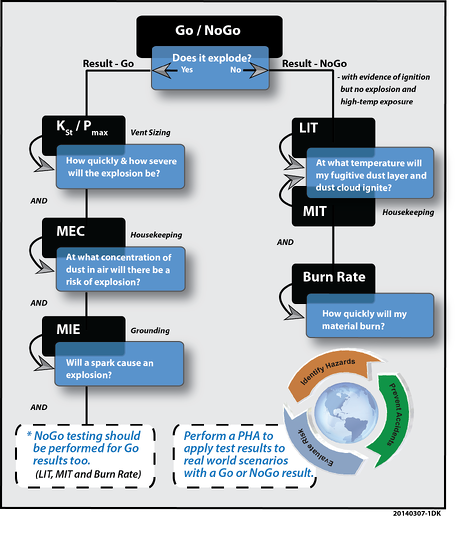Customer inquiry inspired us to develop the Combustible Dust Flowchart to help guide the decision-making process when dealing with a potentially combustible dust. We realize that Combustible Dust is not a subject most people talk about every day. In fact, many people are unaware of what a combustible dust is, or how to go about appropriately managing a potential dust hazard. The Combustible Dust Flowchart walks through basic elements of the testing process, from the initial screening (to see if the dust is explosible), to the other tests that may be needed to give vital information to protect equipment or a facility.
decision-making process when dealing with a potentially combustible dust. We realize that Combustible Dust is not a subject most people talk about every day. In fact, many people are unaware of what a combustible dust is, or how to go about appropriately managing a potential dust hazard. The Combustible Dust Flowchart walks through basic elements of the testing process, from the initial screening (to see if the dust is explosible), to the other tests that may be needed to give vital information to protect equipment or a facility.
The process of managing a potential dust hazard is made challenging by the fact that there are several different official standards that guide combustible dust management (like NFPA 654, NFPA 68, etc), and there are also several “rules of thumb” that are quoted by people that aren’t familiar with the nuances of combustible dust. For example, some people would say that if dust is larger than 400 microns, it is not explosible. However, we have tested dusts as large as 800 micron and seen it explode!
Another common statement is that if the dust layer in a given facility is less than a paper clip in thickness (or 1/32”), then it is “safe.” While this rule may work in some scenarios, it can be misleading as the explosion hazard from fugitive dust is a function of the minimum explosible concentration (MEC) of the material and the total surface area that the dust layer covers. The important thing to note here is that there are many exceptions to the rule when dealing with dust, so proper testing and risk evaluation at a facility is essential to protect people and equipment.
This is not to say that NFPA codes and these general rules are not helpful in guiding an approach to a combustible dust. In fact, they are essential tools in managing dust concerns. However, the examples given above illustrate that the only real way to understand the hazards associated with a dust is to test the dust and to have an engineering professional determine how to apply the test data to a process. Fortunately, there are specific tests that can give helpful guidance about a dust’s behavior. For example, starting with a screening test will identify whether the dust is explosible or not. If the sample explodes during this screening test, then getting additional test information is important. Common tests like the Explosion Severity Test provide the KSt and Pmax values, which tell how powerful an a potential explosion could be; and tests like the Minimum Ignition Energy (MIE) inform clients how sensitive the dust is to electrical or electrostatic ignition sources.
Even after getting test data, we have many clients that still have questions regarding the application of test data to a given facility. To help with these questions, our Risk Management Group specializes in on-site hazard assessments to ensure that the facility is compliant with relevant NFPA and OSHA requirements relative to combustible dust.
Hopefully, you find this Combustible Dust Flowchart a helpful starting place as you walk down the road of combustible dust management. Let us know what else would help?
If you have any questions regarding this flowchart, or how to manage your combustible dust hazards, please contact Jeff Griffin at griffin@fauske.com or us 630-887-5278.

